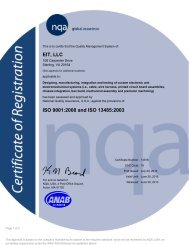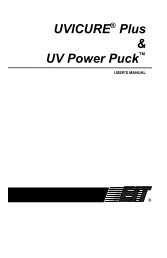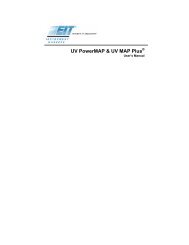UV Measurement & Process Control
UV Measurement & Process Control
UV Measurement & Process Control
Create successful ePaper yourself
Turn your PDF publications into a flip-book with our unique Google optimized e-Paper software.
Are we speaking the same (<strong>UV</strong>) language?Irradiance (Intensity)• Expressed in watts or milliwatts per square centimeter(W/cm 2 or mW/cm 2 )• Total radiant power of (all) wavelengths passing from allincident directions onto an infinitesimally small area (cm 2 )• Depth of cure, penetration through pigments and opaquecolors, adhesion to the substrateRadiant Energy Density• Expressed in joules or millijoulesper square centimeter (J/cm 2 or mJ/cm 2 )• Incorporates time as part of the measurement• One watt for One second = One joule• Area under the irradiance curve• Often the only <strong>UV</strong> exposure guide number supplied• Important for total and complete cure of materialWavelength-Nanometers<strong>UV</strong> Glossary & Terminology: www.radtech.orgDoseIrradiancedAEnergy DensityTime
What ‘dialect’ of <strong>UV</strong> are you speaking?• Instrument Bandwidths are notdefined and vary frommanufacturer to manufacturerand how they are specified• EIT <strong>UV</strong>A 320-390 nm, FullWidth Half Max (FWHM), CWL365 nm• IL <strong>UV</strong>A 250-415 nm CWL365 nm• Specify units in measurementto avoid confusion• <strong>UV</strong>A-University of Virginia• 300 mJ/cm 2 Start• 300 mJ/cm 2 -<strong>UV</strong>A Improvement• 300 mJ/cm 2 -<strong>UV</strong>A EIT 320-390 nm BestEIT<strong>UV</strong>A 320-390 nmIL <strong>UV</strong>A250-415 nmBe specific when communicating instrument values
Why do we measure?• Repeatability• Reliability$• Verification• Documentation• ISO• Training• Quality• Certificate of Conformance/Customer Requirement• Establish, Document and Use <strong>Process</strong> <strong>Control</strong> Limits toavoid <strong>UV</strong> Curing by Guessing!• Art vs. ScienceWaiting to measure until after you have a problem isguaranteed to cost you time and money!
Why didn’t I think to say that…………• Anything that you can measure, you have a betterchance of controlling. Things that you do not measurebecome the cause of mysterious problemsLarry Goldberg-Beta Industries• <strong>UV</strong> can be measured and it can be controlled. If <strong>UV</strong> isnot measured & controlled it will cause mysteriousproblems• Not everything that counts can be counted, and noteverything that can be counted counts. Albert Einstein• Document all process parameters initially and thendecide what is important to continue counting,measuring, controlling and maintaining.
Who is measuring <strong>UV</strong> and what is their motive?Formulator/Chemist• Establish a specification• Determine a process window• Optimize a process• Acquire, service and maintaincustomer• Tend to be absolutemeasurements.Customer/End User(Operator, Maintenance, Business, Quality)• Maintain the process• Troubleshoot and operate in processwindow• Record keeping• Production costs, Scrap, Profit• Tend to be relative measurements.<strong>UV</strong> EquipmentSupplierCommunicationSubstrateSupplierManufacturingEquipmentSupplier<strong>Process</strong> <strong>Control</strong> & <strong>UV</strong><strong>Measurement</strong>InstrumentationCommunicate and Work With Suppliers That Communicate!
Where are we measuring?• <strong>UV</strong>A: 320-390nm Long-wave,blacklight, <strong>UV</strong> Inks,• <strong>UV</strong>B: 280-320nm Middle-wave,erythemal response, medicalapplications• <strong>UV</strong>C: 200-280nm Short-wave,germicidal (254 nm), absorbedby DNA, clear coats, surfacecure, tack, chemical or scratchresistance• <strong>UV</strong>V: 395-445nm Ultra Longwave,wood products,opaques/whites, thick coats,adhesion, depth of cure• V<strong>UV</strong> (Vacuum <strong>UV</strong>): 100-200nm, Ozone < 200 nmDon’t assume, clarify the <strong>UV</strong> bandwidth you are talking about
Where the <strong>UV</strong> goes-relative penetration<strong>UV</strong>C <strong>UV</strong>B <strong>UV</strong>A <strong>UV</strong>VInk, coating, adhesive thicknessSubstrate SurfaceUnderstand what kind and quantity of <strong>UV</strong> your formulation needs tocure. Match the <strong>UV</strong> source and equipment to it
What should we monitor?Dwell Time or Belt/Line Speed• Affects the amount of energy reaching thesubstrate• Actual speeds may vary widely from settingson the speed controller and may not belinear (±25%)• Independently test and confirm dwell time orbelt/line speedRadiant Energy Densitychanges as a function ofthe process speedAt 4 fpm: 2096 mJ/cm 2At 10 fpm: 860 mJ/cm 2143% difference inRadiant Energy Densitybetween the two speedsPeak Irradianceremains the same-Slight 2.9% differenceHour Meter• Number of hours on the current<strong>UV</strong> bulb• Hour meter does not indicate thenumber of starts and stops on thebulb• Hour meter does not indicate atwhat temperature the bulb wasgenerating <strong>UV</strong>• Hour meter does not tell you theamount of <strong>UV</strong> being generated• Hour meter only gives you a roughindication of when you will need toreplace the bulb• Use a radiometer for confirmationEffects of varying the process speed from 4 fpm (blue) to 10 (black) fpm
Electrical Power• Amp MeterWhat should we monitor?• Measures the input power applied to the system• Variations in line voltage (up to 20%), system efficiency• Lamp Power Settings• This is a measure of power applied to the “bulb”• Watts per inch or cm (200-800+ WPI)• WPI/CM estimate:Voltage x Amperage/Arc length of bulb• WPI/CM settings-variations from actual, linearity of system• Power applied to system, not the effective amount of <strong>UV</strong>generated or effective amount reaching the cure surface• Describing lamp power is not the same as describing itsoutput.• A 600 watt/inch lamp does not produce 600 watts/inch of<strong>UV</strong>-it consumes it• Power Supplies• Conventional, Solid State, High Frequency, DC, Square vs.SineLamps with an applied input power of 600 W/inch vary in <strong>UV</strong> output from 6 W/cm 2 (microwave) of <strong>UV</strong>A (EIT 320-390)Do not confuse electrical input power to effective <strong>UV</strong> output.
Where the electrical power goes?Only a small portion of the applied power generates <strong>UV</strong>
What should we monitor?• Before: Readings on a two lamp system• Energy Density: 953 mJ/cm 2 (<strong>UV</strong>A EIT 320-390)390)• Irradiance: 313 mW/cm 2 (<strong>UV</strong>A EIT 320-390)390)• After: Readings on the same system• Energy Density: 1203 mJ/cm 2 (<strong>UV</strong>A EIT 320-390)390) + 26%• Irradiance: 449 mW/cm 2 (<strong>UV</strong>A EIT 320-390)390) + 43%• Only one thing done• Reflectors were cleanedOne little thing can have a big impact in the amount of <strong>UV</strong>reaching the cure surface
ReflectorsWhat should we monitor?• 60-80% of energy reaching the substrate is reflected• Optimize reflected energy, reflector focus and lamp positionthrough design and maintenance programs• Shape, type, material, coating of reflector matched to processElliptical ReflectorsParabolic Reflectors
Impact of System ChangesWhat should we monitor?Focused lamp<strong>UV</strong> W/cm 2Non-Focused lampTime in secondsDistance Change-Same lamp<strong>UV</strong> W/cm 2Dimensional CuringGloss <strong>Control</strong>NON-FOCUSED290 mW/cm 21707 mJ/cm 2FOCUSED858 mW/cm 22096 mJ/cm 2Time in seconds
Life After The <strong>UV</strong> HoneymoonEndMiddleSagging• Middle reading lower on middle to endcomparison• 15 % difference in irradiance levels• Rotate bulbs• Cooling issues?Aging• Middle reading higher• Arc bulb aging on ends•440mW/cm 2 in the middle vs.317 mW/cm 2 atthe end• Width of source to width of product?• Time to replace bulb?MiddleEndMulti-Lamp Systems
What should we monitor? <strong>UV</strong> Spectral Output• Match the <strong>UV</strong> light to your process andchemistry Different types of bulbs, variations inthe bulb over time and variations in the bulbwith power, power supplies• Diameter of bulb, cooling system and airflow inlamp housing• System manufacturer can tell you what types ofbulbs your system can use• Not always interchangeable due to powersupply-kicker• Variations between manufacturers, match toprocess• Ozone producing (more <strong>UV</strong>C) or Ozone free(material)• Buy bulbs based on best value and not thecheapest cost. Watch purchasing staff getting‘specialsBulb Type & Focus Indicator
What should we monitor? <strong>UV</strong> Spectral OutputMercury Lamp Spectra“H” LampIron Additive Lamp Spectra“D” LampGallium Additive Lamp Spectra“V” Lamp
With 600 hours of run time would you change this bulb?OLDNEW<strong>UV</strong>A Energy Density: 537 to 487 mJ/cm 2<strong>UV</strong>A Irradiance: 309 to 290 mW/cm 2 <strong>UV</strong>A EIT 320-390
Change Now?OLDNEW<strong>UV</strong>V Energy Density: 737 to 1331 mJ/cm 2<strong>UV</strong>V Irradiance: 397 to 734 mW/cm 2 <strong>UV</strong>V EIT 395-445
What should we monitor?Do you have any additional parametersunique to your process or environment?Examples:• Inert Curing-Nitrogen, Quartz Plates,Supplier Changes• Temperature: Ambient, Exhaust, WaterCooled• Humidity, Static, Handling, Storage
Irradiance• Expressed in watts or milliwatts per square centimeter (W/cm 2 ormW/cm 2 )• Total radiant power of (all) wavelengths passing from all incidentdirections onto an infinitesimally small area (cm 2 )• Depth of cure, penetration through pigments and opaque colors,adhesion to the substrateIrradiance as function of distanceIrradianceDistanceReadings Decrease with the Square of the Distance.
Radiant Energy Density as a Function of Time• Expressed in joules or millijoules per square centimeter(J/cm 2 or mJ/cm 2 )• Incorporates time as part of the measurement• One watt for One second = One joule• Area under the irradiance curve• Often the only <strong>UV</strong> exposure guide number supplied• Important for total and complete cure of materialEnergy DensityTime
Equal Joules = Equal Cure?• Area in each figure approximately equal• Represents the “area under the curve” or Joules/cm 2• Equal Joules ≠ Equal Cure?IrradianceTime
How do we measure?Absolute Instruments• Absolute units (mJ/cm 2 andmW/cm 2 ), compare readings betweencuring units and locationsRelative Instruments• Relative units, electronic signalproportional to lamp brightness (%intensity), on line continuousmonitoring, feedback to display, PLC
<strong>UV</strong> Instrument SelectionEvaluate Application• Linear• Linear travel, flat• Area Flood• Flat or complex travel, lowerirradiance levels, motionvaries from timed exposurewith no movement tocomplex• Spot• Small areas, liquid or fiberguides• Other• GermicidalSelect Right Instrument For Application• Reading Type• Size• Absolute or Relative• Product Type• Continuous-online• Numeric Display of Irradiance & Energy Density• Profiling-irradiance over time• Source/Bulb Type• Arc• Microwave• Pulsed (Xenon)• LED• Bandwidth(s)• (<strong>UV</strong>A, <strong>UV</strong>B, <strong>UV</strong>C, <strong>UV</strong>V)• Dynamic Range• Exposure vs. curing• But I get readings…..• User Expectations
<strong>UV</strong> Bandwidths60504030CBAV201000 100 200 300 400 500 600<strong>UV</strong>A, <strong>UV</strong>B, <strong>UV</strong>C, <strong>UV</strong>V (EIT)<strong>UV</strong>A2 (EIT)
State of the Art Equipment• Touch screen PLCcontroller• Focus Adjustment• Image based controls• Lamp status• Trouble shooting guides• On-Line DisplaysLamp 100%Images courtesy of Miltec <strong>UV</strong> & InPro Technologies
<strong>UV</strong> <strong>Measurement</strong> and <strong>Process</strong> <strong>Control</strong>• We aren’t smart enough to know what matters and what doesn’t so we copyeverythingBrian Harrison-Intel• Be as smart as the folks at Intel• Goals are deceptive-the unaimed arrow never missesCharles Knief (Kimo’s Rules)• Great advice for a vacation or beachcombers lifestyle• Know your process & process window, know you will have a job• <strong>UV</strong> measurement can’t help you unless you document and record thereadings!Jim Raymont-EIT• Where did I put those <strong>UV</strong> readings?.......
$• The range in which a process will work with the desired results• Adhesion, hardness, flexibility, gloss, texture, stain or scratch resistance,chemical rub, cross hatch, abrasion rub, color ID, registration• Ideal if the <strong>Process</strong> Window is forgiving and has a wide latitude. It takes workand time• Invest before production & confirm when things are working!• Starting guidelines from formulator?• Operator Training, ISO/Procedure Documentation• Define your lower limits and document the readings• Increase line speed/decrease applied power until you undercure, notereadings and cushion by 20%• Upper limits?• Monitor your readings by job, hour, shift or day as required to maintain quality• Establish your process window during the design/development phase• Establish your process window when things are working<strong>Process</strong> Window
<strong>Process</strong> or Cure WindowNormal Operating WindowCaution 20% Undercure Buffer RangeStop!Undercure Limit
<strong>Process</strong> or Cure Window for TemperatureSensitive SubstratesStop! Over temperature limit?Caution 20% Over temperature Buffer RangeNormal Operating WindowCaution 20% Undercure Buffer RangeStop!Undercure Limit
Sample Job LogDateLine Speed DwellTimeFPM<strong>UV</strong> System: North Line Lamp: 2OtherSignatureInd.Actual.PowerWPIHourMeterIrradiance(W/cm 2 )EnergyDensity(J/cm 2 )2/1725224007800.8591.45Equipment variables• Indicated vs. actual process speedFor each <strong>UV</strong> lamp system• Hour meter• Power settings (WPI, Amps)• Irradiance (W/cm 2 )• Radiant Energy Density(J/cm 2 )• Lamp matched to chemistry• Focus/Reflector conditionOther things to consider• Date/job number• Operator signature• Mesh count• Formulation type• Pass/fail on specific QC tests-cross hatch,rub, registration• Maintenance log of system• Maintenance due date• Radiometer type/bandwidths
Outside the <strong>Process</strong> Window?• PANIC!!!!!!! Call Formulator!!!!! Point Fingers!!!!!• Relax and breathe deep! You have the process windowestablished! Right?• Gradual change towards caution area?• Which way do you have to go?• Perform system maintenance• Measure,Clean, Rotate, Measure. Any Improvement?• Replace lamps or adjust user controlled variables untilyou are back in your process window• Work and communicate with suppliers in good times andbad timesGet into “predict and perform preventative maintenance” routinevs. a “fix it when it breaks” routine6 P’s: Proper Prior Planning Prevents Poor Performance
<strong>UV</strong> Formulation SpecificationsOriginal FormulatorSpecification:2x Hg lamps 80 W/cm, 5meters/minute, forward feedImproved Specification:• 2x Hg lamps 80 W/cm, 5 metersper minute, forward feed• Joules or Watts more important?• One 160-200 W/cm lamp work?• Lamp Type? (H, D, V)• Reflector type?• Thermal?• Coating Thickness (Mils?)Distance from the lamp• Focus? Non Focus?Radiometer values• Minimum irradiance• Minimum energy density• Instrument type• Bandwidth• 650 mW/cm 2 , EIT <strong>UV</strong>A (320-390)• 700 mJ/cm 2 , EIT <strong>UV</strong>A (320-390)• <strong>UV</strong>B?, <strong>UV</strong>V?, <strong>UV</strong>C?
Understanding your instrument (and its limits)• Treat and handle as an instrument• Maintain on daily basis, calibrate & service as required• Users expect the same accuracy as other instruments-currentradiometer technology ± 10%• Optics• Filter and detector specifications• Spatial response (Cosine Response)• Design-Balance between optical stability (minimal solarization) andrepeatable electronic signal level• Electronics• Temperature sensitivity• Sample rates/Data collection speeds• Improvements in electronics since early instruments• User induced errors and comparisons (real vs. perceived)• Comparison to other productsUse your instrument within design specsPICNIC errors: Problem in chair, not in calibration
Why Calibrate?• Balance the amount of IR, Visible and <strong>UV</strong> the optics and detector “see” withthe output signal from the detector• Compensate for changes in the optics over time• Solarization• Instruments used in harsh production & manufacturing environments• Irradiance levels:• Sunlight: +/- 20 mW/cm 2• Production <strong>UV</strong> levels: 100’s to 1000’s mW/cm 2• Physical damage to instrument• Drop, crush instrument, scratch optics• Optics/instrument coated with ?• Electronics checkup• Physical and/or heat related damage
Instrument Optics• Normal to expectsmall variationsbetween filters• Test each opticalcomponent to avoidwide variations• Tradeoff is $ vs.performance• Select & test theoptics for betterperformance andunit to unitcomparisons%T100.00090.00080.00070.00060.00050.00040.00030.00020.00010.0000.000300306312318324330336342348354360366372378384390396402408wave length (nm)
Instrument Optics: Spatial ResponseE θ = E x CosθθCosine Response in <strong>Measurement</strong>
Instrument Optics: Spatial Response45 o = .7 Watt 90 o = 1.0 WattE θ = E x CosθθCosine Response in <strong>Measurement</strong>
Instrument ElectronicsThreshold• Irradiance level which causes the unit tostart measuring <strong>UV</strong>• Counts all <strong>UV</strong> past that point• Varies due to scale, electronicresponse, optics, design• Use right dynamic range (scale) ofinstrument40 mWTemperature• Unknowingly introduce variations toreadings based on the internaltemperature of the unit• As detector temperature raises, readingsmay drop• Try to maintain consistent conditions andavoid rapid, repeated, long duration highintensity runs• If it’s s too hot to touch – it’s s too hot tomeasure
Instrument ElectronicsInstrument Sample Rate• Unknowingly introduce variations to readingbased on the sample rate of the unit• Did the unit collect an adequate number ofsamples to produce a number you can trust?• Slower is better-irradiance values should besimilar, calculate energy density informationfrom the reading at a slow speed
Instrument with Low Sampling Rate & Fast Belt SpeedIrradianceTime
Instrument with Faster Sampling RateIrradianceTime
What ‘dialect’ of <strong>UV</strong> Watts are you speaking?• Over head lights-on or on/offat 60/50 Hz?• Sampling rate/electronics ofthe unit• Yesterday: 5-25sample/second• Today: 128-30,000samples/sec• Average Peak irradiance:(Smooth On): 910 mW/cm 2• Peak-Peak irradiance: 1866mW/cm 2 (Smooth Off)• Energy Density:the same• What is the impact?• Power supplies?• Speed limits to process?Be specific when communicating instrument values
Thank YouQuestions?EIT-Instrument Instrument Markets108 Carpenter DriveSterling, VA 20164 USAP:703-478478-0700/F:703-478-0815E:uv@eitinc.comWeb: eitinc.com








